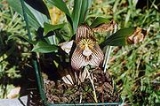
Dracula orchid
Encyclopedia
The orchid genus
Dracula, abbreviated as Drac in horticultural trade, consists of 118 species
. The strange name Dracula, literally means "little dragon", referring to the strange aspect of the two long spurs of the sepal
s. They were once included in the genus Masdevallia
, but became a separate genus in 1978. This genus has some of the more bizarre and well-known species of the subtribe Pleurothallidinae
.
and terrestrial
species are distributed in Central America
and the northwest Andes
, almost half in Ecuador
alone. They prefer shadow and an even, rather cold, temperature.
These caespitose orchids grow in tufts from a short rhizome
, with a dense pack of stems. They lack pseudobulb
s. On each stems grows one large, thin, plicate leaf
with a sharply defined midrib. These glabrous, light to dark green leaves may be spongy, taking over the function of the missing pseudobulb. They are tipped with a mucro (a short tip).
The flower
stalks grow either horizontally from the base of the plant or descend, often for great distances. A few species grow upright flower stalks. The long-tailed terminal flowers are basically triangular. The flowers are borne singly or successively. Three species (sodiroi, decussata/neisseniae, and papillosa) may have up to three simultaneously open flowers on a single stalk. In general, though, if there is more than one flower bud on the raceme, they open up with long intervals. These flowers have a weird aspect, due to the long tails on each sepal
. The petal
s are small and somewhat thickened. The lip
is often quite large for a Pleurothallid and may resemble a mushroom or fungus. The fleshy basal part of the lip (hypochile) is cleft. The terminal part (epichile) is rounded and concave. The margins of the perianth
are often fringed. There is a well-developed column
with two pollinia
.
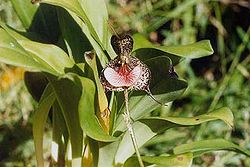
----
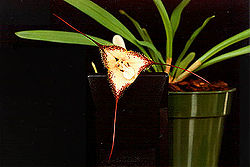
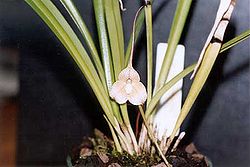
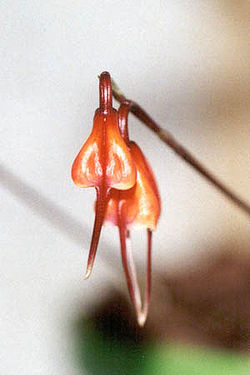
Genus
In biology, a genus is a low-level taxonomic rank used in the biological classification of living and fossil organisms, which is an example of definition by genus and differentia...
Dracula, abbreviated as Drac in horticultural trade, consists of 118 species
Species
In biology, a species is one of the basic units of biological classification and a taxonomic rank. A species is often defined as a group of organisms capable of interbreeding and producing fertile offspring. While in many cases this definition is adequate, more precise or differing measures are...
. The strange name Dracula, literally means "little dragon", referring to the strange aspect of the two long spurs of the sepal
Sepal
A sepal is a part of the flower of angiosperms . Collectively the sepals form the calyx, which is the outermost whorl of parts that form a flower. Usually green, sepals have the typical function of protecting the petals when the flower is in bud...
s. They were once included in the genus Masdevallia
Masdevallia
Masdevallia, abbreviated Masd in horticultural trade, is a large genus of flowering plants of the Pleurothallidinae, a subtribe of the orchid family . There are over 500 species, grouped into several subgenera...
, but became a separate genus in 1978. This genus has some of the more bizarre and well-known species of the subtribe Pleurothallidinae
Pleurothallidinae
The Pleurothallidinae are a neotropical subtribe of plants of the orchid family including 29 genera in more than 4000 species.Naturally occurring species of this subtribe are among the more popular orchids of horticulturalists, especially the genera Dracula, Dryadella, Masdevallia and...
.
Description
These epiphyticEpiphyte
An epiphyte is a plant that grows upon another plant non-parasitically or sometimes upon some other object , derives its moisture and nutrients from the air and rain and sometimes from debris accumulating around it, and is found in the temperate zone and in the...
and terrestrial
Terrestrial plant
A terrestrial plant is one that grows on land. Other types of plants are aquatic , epiphytic , lithophytes and aerial ....
species are distributed in Central America
Central America
Central America is the central geographic region of the Americas. It is the southernmost, isthmian portion of the North American continent, which connects with South America on the southeast. When considered part of the unified continental model, it is considered a subcontinent...
and the northwest Andes
Andes
The Andes is the world's longest continental mountain range. It is a continual range of highlands along the western coast of South America. This range is about long, about to wide , and of an average height of about .Along its length, the Andes is split into several ranges, which are separated...
, almost half in Ecuador
Ecuador
Ecuador , officially the Republic of Ecuador is a representative democratic republic in South America, bordered by Colombia on the north, Peru on the east and south, and by the Pacific Ocean to the west. It is one of only two countries in South America, along with Chile, that do not have a border...
alone. They prefer shadow and an even, rather cold, temperature.
These caespitose orchids grow in tufts from a short rhizome
Rhizome
In botany and dendrology, a rhizome is a characteristically horizontal stem of a plant that is usually found underground, often sending out roots and shoots from its nodes...
, with a dense pack of stems. They lack pseudobulb
Pseudobulb
The pseudobulb is a storage organ derived from the part of a stem between two leaf nodes.It applies to the orchid family , specifically certain groups of epiphytic orchids, and may be single or composed of several internodes with evergreen or deciduous leaves along its length.In some species, it is...
s. On each stems grows one large, thin, plicate leaf
Leaf
A leaf is an organ of a vascular plant, as defined in botanical terms, and in particular in plant morphology. Foliage is a mass noun that refers to leaves as a feature of plants....
with a sharply defined midrib. These glabrous, light to dark green leaves may be spongy, taking over the function of the missing pseudobulb. They are tipped with a mucro (a short tip).
The flower
Flower
A flower, sometimes known as a bloom or blossom, is the reproductive structure found in flowering plants . The biological function of a flower is to effect reproduction, usually by providing a mechanism for the union of sperm with eggs...
stalks grow either horizontally from the base of the plant or descend, often for great distances. A few species grow upright flower stalks. The long-tailed terminal flowers are basically triangular. The flowers are borne singly or successively. Three species (sodiroi, decussata/neisseniae, and papillosa) may have up to three simultaneously open flowers on a single stalk. In general, though, if there is more than one flower bud on the raceme, they open up with long intervals. These flowers have a weird aspect, due to the long tails on each sepal
Sepal
A sepal is a part of the flower of angiosperms . Collectively the sepals form the calyx, which is the outermost whorl of parts that form a flower. Usually green, sepals have the typical function of protecting the petals when the flower is in bud...
. The petal
Petal
Petals are modified leaves that surround the reproductive parts of flowers. They often are brightly colored or unusually shaped to attract pollinators. Together, all of the petals of a flower are called a corolla. Petals are usually accompanied by another set of special leaves called sepals lying...
s are small and somewhat thickened. The lip
Labellum
Labellum is the Latin diminutive of labium, meaning lip. These are anatomical terms used descriptively in biology, for example in Entomology and botany.-Botany:...
is often quite large for a Pleurothallid and may resemble a mushroom or fungus. The fleshy basal part of the lip (hypochile) is cleft. The terminal part (epichile) is rounded and concave. The margins of the perianth
Perianth
The term perianth has two similar but separate meanings in botany:* In flowering plants, the perianth are the outer, sterile whorls of a flower...
are often fringed. There is a well-developed column
Column (botany)
The column, or technically the gynostemium, is a reproductive structure that can be found in several plant families: Aristolochiaceae, Orchidaceae, and Stylidiaceae....
with two pollinia
Pollinium
Pollinium, or plural pollinia, is a coherent mass of pollen grains in a plant.They are the product of only one anther, but are transferred, during pollination, as a single unit. This is regularly seen in plants such as orchids and many species of milkweeds .Most orchids have waxy pollinia...
.

Species
The species of Dracula have tentatively been divided in three subgenera, sections and subsections. The different series in the subsection Dracula are merely an attempt to classify these orchids.- Subgenus Dracula : This subgenus contains all the species of the genus except two exceptional species (D. sodiroi and D. xenos)
- Section Andreettaea : Monotypic: Dracula andreettae
- Section Chestertonia : two species: Dracula chestertonii, D. cutis-bufonis
- Section Cochliopsida : Monotypic: Dracula cochliops
- Section Dodsonia : Four species: Dracula dodsonii, D. insolita, D. iricolor, D. portillae
- Section Dracula : largest section
- Subsection : e.g. Dracula bella, D. vespertilio
- Subsection Dracula :
- Series Dracula : e.g. Dracula chimaera, D. tubeana, D. vampira
- Series Grandiflorae-Parvilabiatae : e.g. Dracula gigas, D. platycrater
- Series Parviflorae : e.g. Dracula houtteana, D. lotax
- Subgenus Sodiroa : Monotypic: Dracula sodiroi
- Subgenus Xenosia : Monotypic : Dracula xenos
----
- Dracula adrianae (Colombia).
- Dracula alcithoe (SW. Colombia to NE. Ecuador).
- Dracula amaliae (W. Colombia).
- Dracula andreettae (W. Colombia to NE. Ecuador).
- Dracula anthracina (NW. Colombia).
- Dracula antonii (Colombia).
- Dracula aphrodes (W. Colombia.
- Dracula astuta (Costa Rica).
- Dracula barrowii (Peru).
- Dracula bellaDracula bellaDracula bella is a species of orchid....
(WC. Colombia). - Dracula bellerophon (W. Colombia).
- Dracula benedictiiDracula benedictiiDracula benedictii is a species of orchid found in Cordillera Central and Cordillera Occidental, Colombia....
(WC. Colombia. - Dracula berthae (Colombia).
- Dracula brangeri (C. Colombia).
- Dracula callithrix (Colombia) - new species 2009 -
- Dracula carcinopsis (W. Colombia).
- Dracula carlueri (Costa Rica).
- Dracula chestertoniiDracula chestertoniiDracula chestertonii, commonly known as the Frog's Skin, is a species of orchid.It was named in honour of the collector Henry Chesterton who discovered this species.-References:...
: Frog's Skin (W. Colombia). - Dracula chimaeraDracula chimaeraDracula chimaera is a species of orchid. It is the type species of the genus Dracula....
(W. Colombia). - Dracula chiroptera (SW. Colombia to NE. Ecuador).
- Dracula christineana (Ecuador).
- Dracula circe (Colombia).
- Dracula citrina (Colombia).
- Dracula cochliopsDracula cochliopsDracula cochliops is a species of orchid....
(SW. Colombia).

- Dracula cordobaeDracula cordobaeDracula cordobae is a species of orchid....
(SW. Ecuador). - Dracula cutis-bufonis : Toadskin Orchid (NW. Colombia).
- Dracula dalessandroi (SE. Ecuador).
- Dracula dalstroemii (NW. Ecuador).
- Dracula decussata (Colombia).
- Dracula deltoidea (SE. Ecuador).
- Dracula deniseana (Peru.
- Dracula diabolaDracula diabolaDracula diabola is a species of orchid that only grows in a single valley in Colombia. Its species name, Diabola, comes from the Latin word for devil....
(Colombia). - Dracula diana (W. Colombia).
- Dracula dodsonii (Colombia to NC. Ecuador)
- Dracula erythrochaete (Costa Rica to W. Panama).
- Dracula exasperata ( SW. Colombia.
- Dracula fafnir (SE. Ecuador).
- Dracula felixDracula felixDracula felix is a species of orchid....
(SW. Colombia to NW. Ecuador). - Dracula fuligifera (C. Ecuador).
- Dracula gastrophora (Ecuador).
- Dracula gigasDracula gigasDracula gigas is a species of orchid....
(W. Colombia to NW. Ecuador). - Dracula gorgona (W. Colombia)
- Dracula gorgonella (Colombia)
- Dracula hawleyi (NW. Ecuador).
- Dracula hirsuta (SE. Ecuador).
- Dracula hirtzii (SW. Colombia to NW. Ecuador).

- Dracula houtteanaDracula houtteanaDracula houtteana is a species of orchid....
(Colombia). - Dracula inaequalisDracula inaequalisDracula inaequalis is a species of orchid....
(W. Colombia). - Dracula incognita (Colombia).
- Dracula inexperata (Costa Rica).
- Dracula insolita (W. Colombia).
- Dracula janetiae (C. Peru)
- Dracula kareniae (Ecuador).
- Dracula lafleurii (NW. Ecuador).
- Dracula lehmanniana (SW. Colombia).
- Dracula lemurella (Colombia).
- Dracula leonum (Peru).
- Dracula levii (SW. Colombia to NW. Ecuador).
- Dracula ligiae (Colombia).
- Dracula lindstroemii (NW. Ecuador).
- Dracula lotaxDracula lotaxDracula lotax is a species of orchid....
(Ecuador). - Dracula mantissa (SW. Colombia to NW. Ecuador).
- Dracula marsupialis (NW. Ecuador).
- Dracula mendozae Luer & V.N.M.Rao (Ecuador)
- Dracula minaxDracula minaxDracula minax is a species of orchid....
(Colombia). - Dracula mopsusDracula mopsusDracula mopsus is a species of orchid....
(Ecuador. - Dracula morleyi (NW. Ecuador).
- Dracula navarrorum (Ecuador).
- Dracula nigritella (Ecuador).
- Dracula nosferatu (Colombia).
- Dracula nycterina (Colombia).
- Dracula octavioiDracula octavioiDracula octavioi is a species of orchid....
(SW. Colombia. - Dracula olmosii (Panama).
- Dracula ophioceps (SW. Colombia).
- Dracula orientalis (NE. Colombia).
- Dracula ortiziana (W. Colombia).
- Dracula papillosa (NW. Ecuador).
- Dracula pholeodytes (NE. Colombia).
- Dracula pileus (W. Colombia).
- Dracula platycrater (Colombia.
- Dracula polyphemusDracula polyphemusDracula polyphemus is a species of orchid....
(NW. Ecuador). - Dracula portillae (SE. Ecuador).
- Dracula posadarumDracula posadarumDracula posadarum is a species of orchid....
(Colombia). - Dracula presbys (Colombia).
- Dracula psittacinaDracula psittacinaDracula psittacina is a species of orchid....
(Colombia). - Dracula psyche (NW. Ecuador).
- Dracula pubescens (Ecuador).
- Dracula pusillaDracula pusillaDracula pusilla is a species of orchid....
(SE. Mexico to C. America) - Dracula radiella (NW. Ecuador).
- Dracula radiosaDracula radiosaDracula radiosa is a species of orchid endemic to Colombia....
(E. Colombia to NW. Ecuador). - Dracula rezekiana (Ecuador).
- Dracula ripleyanaDracula ripleyanaDracula ripleyana is a species of orchid....
(Costa Rica). - Dracula robledorum (Colombia)
- Dracula rojasii (Colombia) - new species 2009 -
- Dracula roezlii (W. Colombia).
- Dracula saulii (Peru).
- Dracula schudelii (Ecuador).
- Dracula senex-furens(Colombia) - new species 2009 -
- Dracula sergioiDracula sergioiDracula sergioi is a species of orchid....
(Colombia). - Dracula severa (NW. Colombia).
- Dracula sibundoyensis (SW. Colombia to NW. Ecuador).
- Dracula sijmii (Ecuador).
- Dracula simia (SE. Ecuador).

- Dracula sodiroiDracula sodiroiDracula sodiroi is a species of orchid....
(Ecuador).- Dracula sodiroi subsp. erythrocodon (Ecuador). Hemicr.
- Dracula sodiroi subsp. sodiroi (Ecuador). Hemicr.
- Dracula syndactylaDracula syndactylaDracula syndactyla is a species of orchid....
(SW. Colombia). - Dracula terborchii (Ecuador).
- Dracula trichromaDracula trichromaDracula trichroma is a species of orchid....
(W. Colombia to NW. Ecuador). - Dracula trinympharum (NW. Ecuador).
- Dracula tsubotae (Colombia).
- Dracula tubeana (Ecuador).
- Dracula ubanginaDracula ubanginaDracula ubangina is a species of orchid. It was classified in the 1980s and is native to Ecuador....
(Ecuador). - Dracula vampiraDracula vampiraDracula vampira is an epiphytic orchid species, endemic to Ecuador.-Description:The orchid has large distinctive flowers; the sepals are rounded with the top corner pulled into a thin tail, which may extend up to 11 cm in length. Although green in colour, the sepals are covered by numerous...
(Ecuador). - Dracula veliziana (Colombia).
- Dracula velutinaDracula velutinaDracula velutina is a species of orchid....
(NW. Colombia). - Dracula venefica (W. Colombia.
- Dracula venosaDracula venosaDracula venosa is a species of orchid....
(W. Colombia to NW. Ecuador). - Dracula verticulosaDracula verticulosaDracula verticulosa is a species of orchid....
(W. Colombia). - Dracula vespertilioDracula vespertilioDracula vespertilio is a species of orchid....
(Nicaragua to NW. Ecuador). - Dracula villegasii (Colombia).
- Dracula vinacea (NE. Colombia).
- Dracula vlad-tepes (NE. Colombia).
- Dracula wallisii (W. Colombia).
- Dracula woolwardiae (Ecuador).
- Dracula xenos (Colombia).
Hybrids
- Dracula × anicula (D. cutis-bufonis × D. wallisii) (Colombia).
- Dracula × radiosyndactyla (D. radiosa × D. syndactyla) (SW. Colombia).

